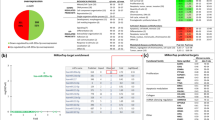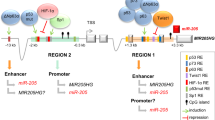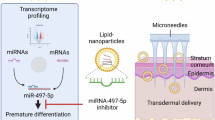Abstract
The epidermis, the outer layer of the skin composed of keratinocytes, is a stratified epithelium that functions as a barrier to protect the organism from dehydration and external insults. The epidermis develops depending on the transcription factor p63, a member of the p53 family of transcription factors. p63 is strongly expressed in the innermost basal layer where epithelial cells with high clonogenic and proliferative capacity reside. Deletion of p63 in mice results in a dramatic loss of all keratinocytes and loss of stratified epithelia, probably due to a premature proliferative rundown of the stem and transient amplifying cells. Here we report that microRNA (miR)-203 is induced in vitro in primary keratinocytes in parallel with differentiation. We found that miR-203 specifically targets human and mouse p63 3′-UTRs and not SOCS-3, despite bioinformatics alignment between miR-203 and SOCS-3 3′-UTR. We also show that miR-203 overexpression in proliferating keratinocytes is not sufficient to induce full epidermal differentiation in vitro. In addition, we demonstrate that miR-203 is downregulated during the epithelial commitment of embryonic stem cells, and that overexpression of miR-203 in rapidly proliferating human primary keratinocytes significantly reduces their clonogenic capacity. The results suggest that miR-203, by regulating the ΔNp63 expression level, is a key molecule controlling the p63-dependent proliferative potential of epithelial precursor cells both during keratinocyte differentiation and in epithelial development. In addition, we have shown that miR-203 can regulate ΔNp63 levels upon genotoxic damage in head and neck squamous cell carcinoma cells, thus controlling cell survival.
Similar content being viewed by others
Log in or create a free account to read this content
Gain free access to this article, as well as selected content from this journal and more on nature.com
or
Abbreviations
- ES cells:
-
embryonic stem cells
- HEK:
-
human epidermal keratinocytes
- HNSCC:
-
head and neck squamous cell carcinomas
- K:
-
keratin
- miR:
-
microRNA
- p63−/−:
-
mouse knockout for p63
- TA:
-
transactivation domain
- TA cells:
-
transient amplifying cells
- TG:
-
transglutaminase
- ΔN:
-
amino-terminal truncated protein
References
Candi E, Schmidt R, Melino G . The cornified envelope: a model of cell death in the skin. Nat Rev Mol Cell Biol 2005; 6: 328–340.
Blanpain C, Fuchs E . Epidermal stem cells of the skin. Ann Rev Cell Dev Biol 2006; 22: 339–373.
Senoo M, Pinto F, Crum CP, McKeon F . p63 Is essential for the proliferative potential of stem cells in stratified epithelia. Cell 2007; 129: 523–536.
Yang A, Kaghad M, Wang Y, Gillett E, Fleming MD, Dötsch V et al. p63, a p53 homolog at 3q27–29, encodes multiple products with transactivating, death-inducing, and dominant-negative activities. Mol Cell 1998; 2: 305–316.
Yang A, Schweitzer R, Sun D, Kaghad M, Walker N, Bronson RT et al. p63 is essential for regenerative proliferation in limb, craniofacial and epithelial development. Nature 1999; 398: 714–718.
Mills AA, Zheng B, Wang XJ, Vogel H, Roop DR, Bradley A . p63 is a p53 homologue required for limb and epidermal morphogenesis. Nature 1999; 398: 708–713.
Ambros V . The functions of animal microRNAs. Nature 2004; 431: 350–355.
Bartel DP . MicroRNAs: genomics, biogenesis, mechanism, and function. Cell 2004; 16: 281–297.
Kim VN . MicroRNA biogenesis: coordinated cropping and dicing. Nat Rev Mol Cell Biol 2005; 6: 376–385.
Chen CZ, Li L, Lodish HF, Bartel DP . MicroRNAs modulate hematopoietic lineage differentiation. Science 2004; 303: 83–86.
Poy MN, Eliasson L, Krutzfeldt J, Kuwajima S, Ma X, Macdonald PE et al. A pancreatic islet-specific microRNA regulates insulin secretion. Nature 2004; 432: 226–230.
He L, Thomson JM, Hemann MT, Hernando-Monge E, Mu D, Goodson S et al. A microRNA polycistron as a potential human oncogene. Nature 2005; 435: 828–833.
O′Donnell KA, Wentzel EA, Zeller KI, Dang CV, Mendell JT . c-Myc-regulated microRNAs modulate E2F1 expression. Nature 2005; 435: 839–843.
Zhao Y, Samal E, Srivastava D . Serum response factor regulates a muscle-specific microRNA that targets Hand2 during cardiogenesis. Nature 2005; 436: 214–220.
Knight SW, Bass BL . A role for the RNase III enzyme DCR-1 in RNA interference and germ line development in Caenorhabditis elegans. Science 2001; 293: 2269–2271.
Bernstein E, Kim SY, Carmell MA, Murchison EP, Alcorn H, Li MZ et al. Dicer is essential for mouse development. Nat Genet 2003; 35: 215–217.
Murchison EP, Partridge JF, Tam OH, Cheloufi S, Hannon GJ . Characterization of Dicer-deficient murine embryonic stem cells. Proc Natl Acad Sci USA 2005; 102: 12135–12140.
Yi R, O′Carroll D, Pasolli HA, Zhang Z, Dietrich FS, Tarakhovsky A et al. Morphogenesis in skin is governed by discrete sets of differentially expressed microRNAs. Nat Genet 2006; 38: 356–362.
Andl T, Murchison EP, Liu F, Zhang Y, Yunta-Gonzalez M, Tobias JW et al. The miRNA-processing enzyme dicer is essential for the morphogenesis and maintenance of hair follicles. Curr Biol 2006; 16: 1041–1049.
Sonkoly E, Wei T, Janson PC, Sääf A, Lundeberg L, Tengvall-Linder M et al. A MicroRNAs: novel regulators involved in the pathogenesis of Psoriasis? PLoS ONE 2007; 2: e610.
Rossi M, Aqeilan RI, Neale M, Candi E, Salomoni P, Knight RA et al. The E3 ubiquitin ligase Itch controls the protein stability of p63. Proc Natl Acad Sci USA 2006; 103: 12753–12758.
Candi E, Rufini A, Terrinoni A, Giamboi-Miraglia A, Lena AM, Mantovani R et al. DeltaNp63 regulates thymic development through enhanced expression of FgfR2 and Jag2. Proc Natl Acad Sci USA 2007; 104: 11999–12004.
Candi E, Rufini A, Terrinoni A, Dinsdale D, Ranalli M, Paradisi A et al. Differential roles of p63 isoforms in epidermal development: selective genetic complementation in p63 null mice. Cell Death Differ 2006; 13: 1037–1047.
Lee H, Kimelman D . A dominant-negative form of p63 is required for epidermal proliferation in zebrafish. Dev Cell 2002; 2: 607–616.
Truong AB, Kretz M, Ridky TW, Kimmel R, Khavari PA . p63 regulates proliferation and differentiation of developmentally mature keratinocytes. Genes Dev 2006; 20: 3185–3197.
Barrandon Y, Green H . Three clonal types of keratinocyte with different capacities for multiplication. Proc Natl Acad Sci USA 1987; 84: 2302–2306.
Gambaro K, Aberdam E, Virolle T, Aberdam D, Rouleau M . BMP-4 induces a Smad-dependent apoptotic cell death of mouse embryonic stem cell-derived neural precursors. Cell Death Differ 2006; 13: 1075–1087.
Aberdam D, Gambaro K, Medawar A, Aberdam E, Rostagno P, de la Forest Divonne S et al. Embryonic stem cells as a cellular model for neuroectodermal commitment and skin formation. C R Biol 2007; 330: 479–484.
Rocco JW, Leong CO, Kuperwasser N, DeYoung MP, Ellisen LW . p63 mediates survival in squamous cell carcinoma by suppression of p73-dependent apoptosis. Cancer Cell 2006; 9: 45–56.
Tonon G, Wong KK, Maulik G, Brennan C, Feng B, Zhang Y et al. High-resolution genomic profiles of human lung cancer. Proc Natl Acad Sci USA 2005; 102: 9625–9630.
Hibi K, Trink B, Patturajan M, Westra WH, Caballero OL, Hill DE et al. AIS is an oncogene amplified in squamous cell carcinoma. Proc Natl Acad Sci USA 2000; 97: 5462–5467.
Forastiere A, Koch W, Trotti A, Sidransky D . Head and neck cancer. N Engl J Med 2001; 345: 1890–1900.
Rocco JW, Ellisen LW . p63 and p73: life and death in squamous cell carcinoma. Cell Cycle 2006; 5: 936–940.
Ratovitski E, Trink B, Sidransky D . p63 and p73: teammates or adversaries? Cancer Cell 2006; 9: 1–2.
DeYoung MP, Johannessen CM, Leong CO, Faquin W, Rocco JW, Ellisen LW . Tumor-specific p73 up-regulation mediates p63 dependence in squamous cell carcinoma. Cancer Res 2006; 66: 9362–9368.
Yi R, Poy MN, Stoffel M, Fuchs E . A skin microRNA promotes differentiation by repressing ‘stemness’. Nature 2008; 452: 225–229.
Zangen R, Ratovitski E, Sidransky D . DeltaNp63alpha levels correlate with clinical tumor response to cisplatin. Cell Cycle 2005; 4: 1313–1315.
Yuspa SH, Kilkenny AE, Steinert PM, Roop DR . Expression of murine epidermal differentiation markers is tightly regulated by restricted extracellular calcium concentrations in vitro. J Cell Biol 1989; 109: 1207–1217.
Lewis BP, Shih IH, Jones-Rhoades MW, Bartel DP, Burge CB . Prediction of mammalian microRNA targets. Cell 2003; 115: 787–798.
Acknowledgements
We thank Dr. Alessandro Giamboi Miraglia for technical support and Angelo Peschiaroli and Alessandro Terrinoni for scientific discussion. The work reported in this manuscript has been supported by the Medical Research Council (GM) and by grants from Telethon (GGP02251 to EC), AIRC (2743 to GM), EU (LSGBH-2005-019067-Epistem; LSHC-CT-2004-503576-Active p53) to GM, MIUR to GM, PRIN 06 to EC, PRIN 06 to GM, MinSan to GM, and by ANR (ANR-06-BLAN-0367) and EU (LSGBH-2005-019067-Epistem) to DA.
Author information
Authors and Affiliations
Corresponding authors
Additional information
Edited by P Vandenabeele
Supplementary Information accompanies the paper on Cell Death and Differentiation website (http://www.nature.com/cdd)
Supplementary information
Rights and permissions
About this article
Cite this article
Lena, A., Shalom-Feuerstein, R., di Val Cervo, P. et al. miR-203 represses ‘stemness’ by repressing ΔNp63. Cell Death Differ 15, 1187–1195 (2008). https://doi.org/10.1038/cdd.2008.69
Received:
Revised:
Accepted:
Published:
Issue date:
DOI: https://doi.org/10.1038/cdd.2008.69
Keywords
This article is cited by
-
p63: a crucial player in epithelial stemness regulation
Oncogene (2023)
-
Identification and functional validation of SRC and RAPGEF1 as new direct targets of miR-203, involved in regulation of epidermal homeostasis
Scientific Reports (2023)
-
Differentially expressed miRNAs associated with generalized aggressive periodontitis
Clinical Oral Investigations (2023)
-
Reversal of dual epigenetic repression of non-canonical Wnt-5a normalises diabetic corneal epithelial wound healing and stem cells
Diabetologia (2023)
-
Tear miRNA expression analysis reveals miR-203 as a potential regulator of corneal epithelial cells
BMC Ophthalmology (2021)



